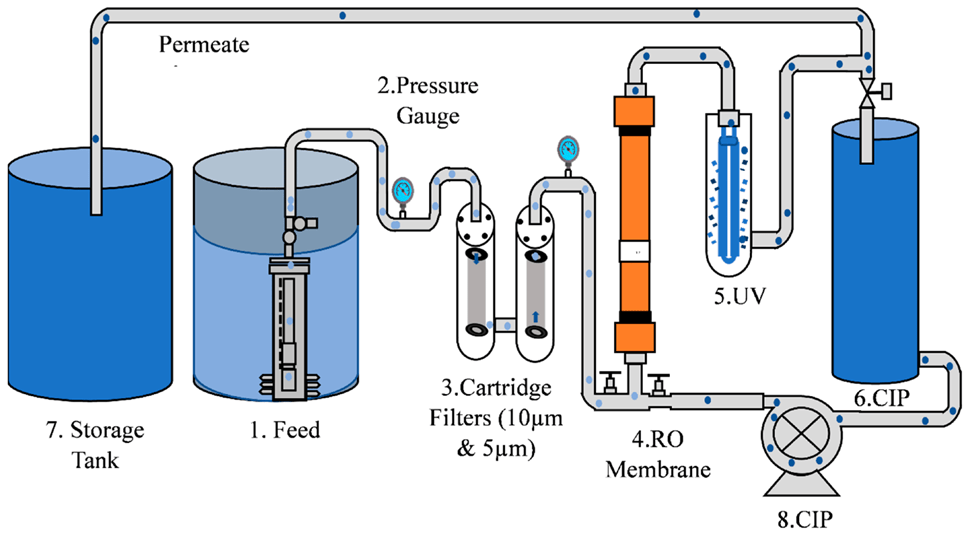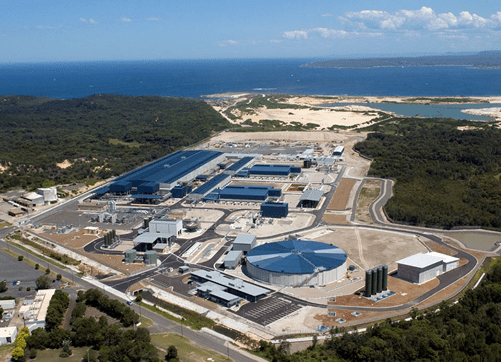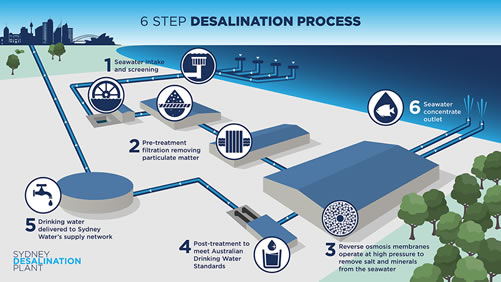- Perspective – April 2024
- Columbus Stainless Advert
- Best of the GPS E-Newsletter
- Novametal South Africa Advertorial
- It’s time to move away from the global plastic addiction to sustainable stainless
- The SASSDA and Columbus Steel Awards are back and they’re better than ever!
- A critical juncture for local stainless steel
- Stainless Steel the ‘salt of the earth ’ when it comes to desalination
- Professional Profile : Nthabiseng Sebelebele
- A Fond Farewell
- West Africa’s economic boom sparks global competition
- Opportunity in West Africa: A focus on Côte d’Ivoire
- Laser welding – a shining light of precision
- NDE Advert
- Membership Benefits
- Fastenright Advert
- Member Profile
- Sassda News
- Membership News
STAINLESS STEEL THE ‘SALT OF THE EARTH’ WHEN IT COMES TO DESALINATION
Cape Town’s proposed new desalination plant has the potential to use 900 to 1000 tons of stainless steel that would be used to construct the desalination unit, connecting pipework, other equipment such as pumps and valves for the unit, and its auxiliary systems and general infrastructure. In this issue’s Focus Feature, we take a deep dive into the concept of desalination and the potential for its use in this vital project…
Desalination has become a popular talking point over the past decade in South Africa. During recent droughts along the Southern and Eastern Coastline desalination played an important part in supplying communities with drinkable water. Unfortunately now that the critical need for alternative water sources has been alleviated, the desalination systems until the next crisis.
However, reality dictates that the water crisis is already upon us and that water sources will remain under escalating pressure with an increase in populations in and around the major coastal cities. Whilst the water crisis is spread over the Southern African region due to climate changes and increased demand for water in industry and rural development, desalination is a potential solution to water supply in the coastal regions only.
A complex process
Desalination, in any form, is based on simple principles but highly complicated in practice. It is the process of removing salt and other impurities from seawater to make it drinkable. The two most common methods for desalination are thermal and membrane technologies.
The thermal technology involves heating saline water (seawater) to produce water vapour, which is then condensed and collected as fresh water. This process is called distillation, which involves boiling seawater in a still, collecting steam, and condensing it to obtain fresh water. Distillation is the most obvious method for for up to half of a plant’s production cost. In South Africa, we do not have a constant or consistent energy supply available to see this process as a final solution.
Membrane technology makes use of semi-permeable membranes to separate salts from water. In the Cape Town area, the emergency desalination plants used reverse osmosis, which uses high pressure and a semi-permeable membrane to filter salt and other impurities from water. In reverse osmosis, water from the ocean is forced through thousands of tightly wrapped, semi-permeable membranes under extremely high pressure. The membranes allow the smaller water molecules to pass through, leaving salt and other impurities behind.
Desalination processes are still developing and there are a number of other technologies available as alternative solutions. One of them would be so-called multiple effect distillation (MED) which uses heat and electricity to produce potable water. The water to be treated passes through a set of evaporators in series. The steam from one cell is used to evaporate the water in the following, while the primary energy input is to the first stage. Typically, MED systems have multiple chambers and hot steam from a nuclear power plant is carried into the chamber through pipes, repelling seawater on the pipes.

Another method would be electrodialysis (ED) in which an electric field is used to separate any dissolved salts from water. The process involves the use of ionselective membranes that allow either positive or negative ions to pass through while retaining the opposite ions. Electrodialysis has many applications, including desalination, table salt production, wine stabilisation, whey demineralisation, and pickling bath recovery.

What does a desalination plant for a city look like?

Spain is the world’s fifth largest producer of desalinated water, with 770 large-scale desalination plants, 99% of which are high capacity installations. A good example would be the Valdelentisco Desalination Plant in Murcia, Spain, which uses pumps to move water from the raw water tank to sand filters. The water is then passed through cartridge filters made of rubber-coated carbon steel, which filter the water through polypropylene ore size 5µm.
In Sydney, Australia, seawater is drawn from the Tasman Sea through four intake pipes on the seabed, about 25 m below the water level. At full capacity, the intake pipes deliver about six hundred million litres of seawater daily to the plant via a 2.5 m diameter concrete tunnel.
Drum screens are used to remove any large materials that may enter through the intake tunnel. The plant’s pre- treatment filter system removes any solid material, such as algae and small dirt particles to get the seawater as clean as possible before the reverse osmosis process. The seawater is filtered through layers of filter coal and sand to prepare it for the reverse osmosis process. The clean filtered seawater passes through 36 000 reverse osmosis membranes so any salt and other minerals can be removed. The water is pushed at high pressure (60bar) through the semi-permeable membranes, which function as a filter for the salt and minerals and only allow fresh water to pass through.

The freshwater produced by the reverse osmosis process requires minerals to be added before it is fluoridated and chlorinated, in line with Australian Drinking Water Guidelines and NSW Health requirements. Two large pumps transfer the water from the drinking water storage tank into a pipeline to the end-users.
Approximately 58% of the water used during the desalination process is returned to the ocean. This water is known as seawater concentrate (effectively saltier seawater) and is transported back to the ocean via an outlet tunnel and specially designed outlet dispersion nozzles. These nozzles make sure the water mixes rapidly and returns to normal seawater salinity and temperature within a short distance of its discharge point so as not to harm the local marine environment.
How much stainless steel is used in desalination?
One should distinguish between the desalination processes when trying to determine the quantities of stainless steel used in such applications. The tonnage would also depend on the plant’s capacity. The types or grades of stainless steel used in desalination would also be noble or with higher alloying content to protect against harsh conditions in the process.
Since desalination is not common in South Africa, we have no real data on local projects. South Africa is only beginning its feasibility studies on the suitability for such a facility and currently, a study is being finalised for a proposed plant near Cape Town. If this report shows that such a project is feasible, this will be the first permanent installation with this level of capacity in Southern Africa.
Stainless steel in thermal desalination
It would seem that empirical data from the proposed Cape Town project shows that a thermal desalination plant, which produces about 1500 m3/h of distillate, requires 900- 1000 tons of stainless steel. A plant of this capacity will be regarded as medium sized in global terms. The stainless steel would be used to construct the desalination unit, connecting pipework, other equipment such as pumps and valves for the unit, and its auxiliary systems and general infrastructure.
Stainless steel in reverse osmosis systems
The temporary plants used around Cape Town were of the reverse osmosis types. In reverse osmosis plants, there are much lower pressures and thus a high use of PVC and other plastics. The use of stainless steel is limited to the pumps, valves and tubes working at higher pressures. These plants require far less stainless steel than thermal desalination plants; for example, a plant producing 1500m3/h of permeate requires about 30-40 tons of the aforementioned materials.
Conclusion
Desalination is already widespread in some water-stressed areas, like the Gulf region, where Kuwait gets up to 90% of its drinking water from desalination 42% of the United Arab Emirates’ water needs. While desalination is a reliable process used by over three hundred million people worldwide, it has some negative environmental impacts:
- Fossil fuels - Desalination is energy-intensive and uses fossil fuels contributing to global warming.
- Toxic brine - The brine produced by desalination plants can pollute coastal ecosystems.
- Waste and chemicals - Desalination plants produce waste and toxic chemicals that can harm wildlife.
- Greenhouse gas emissions - Desalination plants that use diesel produce greenhouse gas emissions.
- Temperature difference - The temperature of rejected brines is often 10 to 15 degrees Celsius higher than that of ambient saltwater, which can be harmful to marine ecosystems.
- Marine life - Desalination surface water intakes are a huge threat to marine life. For example, the sodium metabisulphite discharged from desalination plants can negatively impact seagrass habitats.
It is clear that desalination is expensive and has significant environmental side effects but in an arid country such as South Africa what would be the alternatives?
Additional reading
- https://sassda.co.za/wp-content/uploads/2024/03/ pdf
- dailymaverick.co.za/article/2023-12-03-cape-town-set-to-purify-treated-sewage-water-for-drinking-purposes

